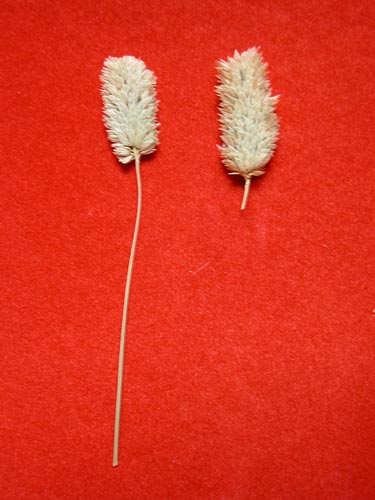Relatives
Phalaris canariensis L. - Canary grass, canary seed or annual canary grass.
Taxonomic position.
Family Poaceae Barnhart., genus Phalaris L.Biology and morphology.
Annual herb; caespitose; leaves scattered along culms. Culms are 80 cm tall, sometimes geniculate at the base, rarely branched above or un-branched above, with 5-6 nodes. Young shoots extra-vaginal. Leaves are non-auriculate. Basal leaf sheaths not keeled, terete, but the sheath of the flag leaf is often large, usually glabrous or scabrous (along the veins); veins are equally striated, membranous, smooth. Ligule is 4.9-8.5 mm long, membranous, smooth, acute to obtuse, full. Leaf blades are flat, linear, usually minutely axially scabrous, shallowly grooved. Inflorescence is a panicle, pallid to green, erect, contracted, 30-40 mm long, commonly ovate or oblong, symmetrical. Spikelets erect, spreading. Plants are bisexual. Hermaphroditic florets are 1 per spikelet, symmetrical, pale golden-brown at maturity. Hermaphroditic spikelets are sub-sessile to pedicellate, 6.4-8.5 mm long, strongly laterally compressed, obovate, but not disarticulating as a separate unit, disarticulating above the glumes. Glumes are two per spikelet, similar, equal in length, longer than the proximal lemma. Incomplete florets are present, in close proximity to the hermaphroditic florets. Incomplete florets are 2 per spikelet, sterile (reduced to leaf-like, well-developed lemmas), clearly specialized and modified in form, awn-less. Rudimentary spikelets occasionally present at the base of the inflorescence, but may be absent. Fruit free from both the lemma and the palea, but firmly enclosed, elliptical, laterally compressed, 4-5 mm long, 1.2-1.7 mm wide, not grooved, glabrous. Blossoms in June; seeds mature in July. Species is cross-pollinated by wind. 2n = 12 (14).Distribution.
Plant is found in the European part of the former USSR (rarely, sometimes adventitious), the Crimea (southern shore), the Caucasus (Dagestan, Talysh), Eastern Siberia (rarely) and the Far East (adventitious).Ecology.
Species occurs as an adventitious plant in populated places, in gardens and in parks. It grows in open, dry habitats in disturbed soils. More sensitive to heat and less drought-tolerant and salt-tolerant than wheat. It does best in heavy, moisture-retentive soils. Canary grass will grow in many types of soils but performs best in heavier, clay loam soils of medium-high fertility. Canary seed requires ample moisture to obtain maximum yields; therefore; it performs poorly in sandier soils. Plants can be very invasive, especially in moist conditions, where dense growth provides good cover for water fowl.Utilization and economic value.
Cultivated for bird seed; also palatable to stock. Other uses, including use as human food, have been proposed. As a bird food, the florets are sold, and the birds de-hull the florets before consumption. It is widely recognized as a superior canary feed. Annual Canary grass seed is similar to oat in mineral composition. The caryopsis is higher in ash, oil, and phosphorus but lower in fiber than corn, pea, or field bean. Canary grass caryopses have higher concentrations of all eight essential amino acids than wheat or corn and are higher in sulfur-containing amino acids than pea or field bean. In spite of this encouraging nutritional profile, the value of canary grass as a human food has not been adequately explored. There is potential for it also as a bio-fuel for an environmentally sound replacement of oil. The leaves can be woven into hats and matting. Good forage plant, too. It can be used for hay, silage, or grain. It is a valuable component in mixtures with annual legumes and sunflower. It is used in pastures before blossoming. Good palatability for cattle and sheep. Protein content is higher than that of most annual grasses (16-17% in dry matter).Reference citations:
Fedorov A.A., ed. 1974. Flora of European part USSR. Vol. 1. Leningrad: Nauka. 404 pp. (In Russian)Grossheim A.A. 1939. Flora of the Caucasus. Vol. 2. Baku: AzFAN. 587 pp. (In Russian)
Gubanov I.A., Kiseleva K.V., Novikov V.S., Tikhomirov V.N. 2002. The illustrated keys to plants of Middle Russia. Vol. 1. Moscow: KMK. 526 p. (In Russian)
Harkhevich S.S., ed. 1985. Vascular Plants of the Soviet Far East. Vol. 1. St. Petersburg: Nauka. 390 p. (In Russian)
Rodjevitz P.U., Schishkin V.K., eds. 1937. Flora of the USSR. Vol. 2. Moscow-Leningrad: USSR. 778 pp. (In Russian)
Shelyak-Sosonko Y.P., ed. 1977. Grasses of Ukraine. Kiev: Naukova Dumka. 518 pp.
Tzvelev N.I., ed. 1974. Flora of the Northeast of the European part of the USSR. Vol. 1. Leningrad: Nauka. 275 pp. (In Russian)
Tzvelev N.N. 1976. Poaceae USSR. Leningrad: Nauka. 788 pp. (In Russian)


